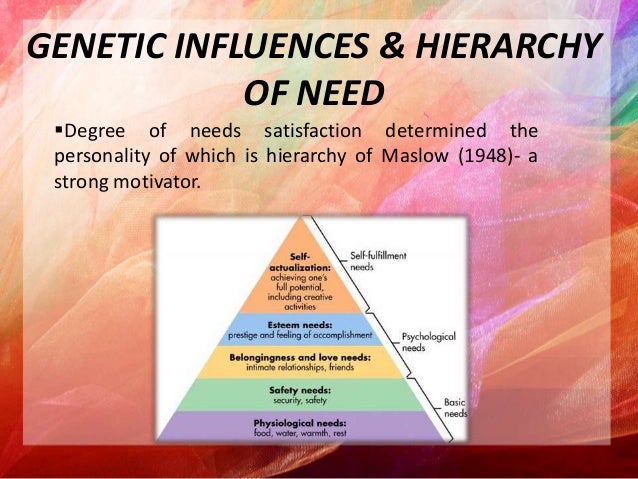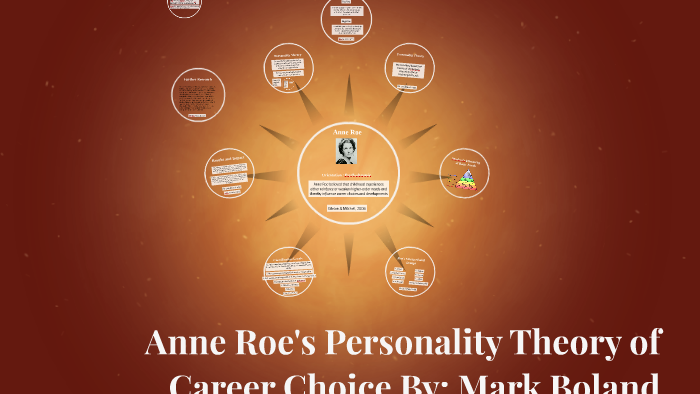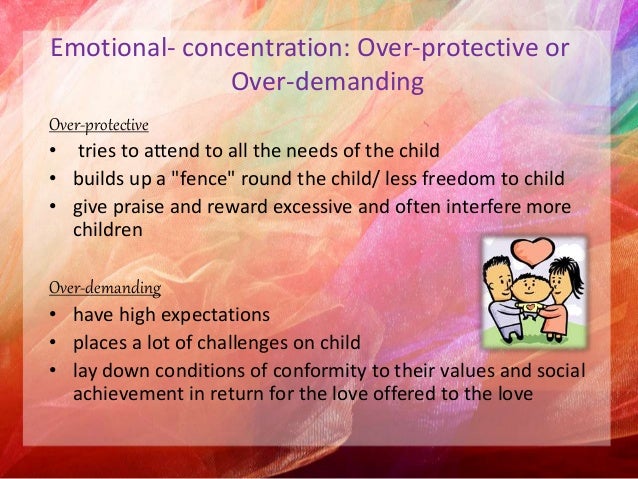Oct 07, 2019 Career development theory is the study of career paths, success and behavior. It aims to explain why a person might be a good fit for a certain career and provide advice on how to attain a promising trajectory. It also focuses on identifying common career stages when education, guidance and other interventions are necessary. Need for Need for information Holland’s Theory (1985), contents that every individual resembles one of six basic personality types and as result manifest some of the behaviours and traits associated with the type. John Holland’s Theory can be said and trace back to his. Roe’s classification system has proven particularly useful to career counselors in the influence it has had in the development of career assessment instruments and in its overall contribution to the mapping of the world of work. References: Osipow, S. H., & Fitzgerald, L. Theories of career development (4th ed.). Boston: Allyn & Bacon.
Abraham Arden Brill (October 12, 1874 – March 2, 1948) was an Austrian-born psychiatrist who spent almost his entire adult life in the United States. He was the first psychoanalyst to practice in the United States and the first translator of Sigmund Freud into English.[1]
- A leading theorist in career development, in 1979 Krumboltz proposed a social learning theory of career decision making. In 1996, he expanded this into a learning theory of career counseling and has since added the concept of planned happenstance.
- Matching theories. Parsons (1908) is regarded as the founder of the vocational guidance movement. He developed the `talent matching' approach which was subsequently developed into the trait and factor theory of occupational choice within the evolving discipline of differential psychology.
Education[edit]
Brill was born in Kańczuga, Austrian Galicia. He arrived in the United States alone and penniless at the age of 15. Working continuously to finance his studies,[2] he eventually graduated from New York University in 1901 and obtained his M.D. from Columbia University in 1903.[3]Ernest Jones commented with admiration: 'He might have been called a rough diamond, but there was no doubt about the diamond'.[2] Brill spent the next 4 years working at Central Islip State Hospital on Long Island.[3]
Life[edit]
Brill married Dr. K. Rose Owen, with whom he had two children. He died at Mount Sinai Hospital in New York on March 2, 1948.[3]
Career[edit]
After studying with Eugen Bleuler in Zurich, Switzerland,[1] he met Freud, with whom he maintained a correspondence until Freud's death in 1939.[1] He returned to the United States in 1908 to become one of the earliest and most active exponents of psychoanalysis, being the first to translate into English most of the major works of Freud, as well as books by Jung. His first translation of Freud appeared in 1909 as Some Papers on Hysteria;[3] and while the quality of his translations might at times be challenged, his overall contribution to the fostering of psychoanalysis in America cannot.[4] He campaigned for academic recognition of his field, lectured at Columbia University, and became clinical professor of psychiatry at New York University.[1] He maintained a psychoanalytic practice as well.
In 1911 he founded the New York Psychoanalytic Society (or Institute) and later helped found the American Psychoanalytic Association.[1] The library of the New York Psychoanalytic Institute is named in his honor.[1] Although opposed in principle to Lay analysis - 'psychoanalysis..can be utilized only by persons who have been trained in anatomy and pathology'[5] - rather than split the International movement, in 1929 he made a tactical concession to Freud,[6] and as head of the New York Psychoanalytic Society, sanctioned the limited introduction of lay analysts to the profession, which had previously restricted its ranks to medical professionals.[7] During the 1930s he played a key role in finding employment for psychiatric professionals exiled from Nazi Europe.[8]
Once sympathetic to homosexuals, he revised his views and wrote in 1940 that 'even so-called classical inverts are not entirely free from some paranoid traits'.[9]
Edward Bernays consulted with Brill on the subject of women's smoking and borrowed the term 'torches of freedom' from Brill.[10]
One of his last pieces of writing - his preface to Eric Berne's 1947 study, The Mind in Action - commends Berne's ability to 'expound the new psychology without the affectivity of the older Freudians', placing his tribute in the context of himself 'having read everything written on Freud and psychoanalysis since I first introduced him here'.[11]
Publications[edit]
- Psychoanalysis: Its Theories and Practical Application (1912)
- Fundamental Conceptions of Psychoanalysis (1921)
- Translations of Freud

- Selected Papers on Hysteria (1909)
- Three Contributions to the Theory of Sex (1910)
- The Interpretation of Dreams (1913)
- The Psychopathology of Everyday Life (1914)
- Selected papers on hysteria and other psychoneuroses (1912)
- Leonardo da Vinci: A PSYCHOSEXUAL STUDY OF AN INFANTILE REMINISCENCE (1916)
- Wit and its relation to the unconscious (1917)
- Totem and Taboo (1919)
- Studies in Hysteria (1937)
- Translations of Jung
- Psychology of Dementia Praecox (1909)
See also[edit]
Anne Roe Career Development Theory Pdf Creator Pdf

References[edit]


- ^ abcdefMishne, Judith Marks (1993). The Evolution and Application of Clinical Theory: Perspective from Four Psychologies. NY: The Free Press. p. 33.
- ^ abP. Gay, Freud (1989) p. 209
- ^ abcd'Dr. A.A. Brill Dies; Psychiatrist, 73'(PDF). New York Times. March 3, 1948. Retrieved March 8, 2013.
- ^Ernest Jones, The Life and Work of Sigmund Freud (1964) p. 335-6 and p. 563-4
- ^P. Gay, Freud (1989) p. 495-8
- ^P. Gay, Freud (1989) p. 499-500
- ^Muckenhoupt, Margaret (1997). Sigmund Freud: Explorer of the Unconscious. NY: Oxford University Press. p. 133.
- ^Friedman, Lawrence Jacob (1999). Identity's Architect: A Biography of Erik H. Erikson. Harvard University Press. p. 111.
- ^Terry, Jennifer (1999). An American Obsession: Science, Medicine, and Homosexuality in Modern Society. University of Chicago Press. pp. 292–3.
- ^1929 Torches of Freedom, The Museum of Public Relations, archived from the original on July 15, 2014, retrieved March 11, 2014
- ^Preface, Eric Berne, A Layman's Guide to Psychiatry and Psychoanalysis (1976) p. 13-4
Further reading[edit]
- Nathan G. Hale: The rise and crisis of psychoanalysis in the United States: Freud and the Americans 1917–1985 (New York, 1995)
External links[edit]
| Wikisource has original works written by or about: Abraham Brill |
- Works by Abraham Brill at Project Gutenberg
- Works by Abraham Brill at LibriVox (public domain audiobooks)
Career Counseling
John Krumboltz posits a theory of career counseling that stresses social learning as its key ingredient. He says that “People with differing genetic characteristics are exposed to infinitely varied learning opportunities (or lack therof) as a result of the social, cultural, and economic circumstances that exist at the time and place where they live. The consequences of these learning experiences are synthesized by each individual…(to) guide each person’s thinking about appropriate career decisions and actions.” (1996, p.60).
Whatever your personal beliefs about whether personality traits are genetic or products of environmental conditions, his theoretical formulations work extremely well within a cognitive behavioral framework. Cognitive Behavioral Therapy (CBT) is probably the most well-known therapy among laypeople. It was developed from the philosophy of the Stoics, a sect of ancient Greeks, and stresses that how we perceive an event is actually what causes a reaction, not the event itself. Most people think in terms of cause and effect. Visually, cause and effect would look like this:
Cognitive Behavioral Therapy places the emphasis on a middle stage that predicts those consequences. Visually, it looks like this:
Much of the work in CBT revolves around addressing and challenging all kinds of faulty thinking that can lead to dysfunction. Let’s use an example to flesh this out. Imagine that you have just transferred to a new high school and people have not been friendly to you on your first day. You walk into the cafeteria at lunch and see a group of people who you assume are the popular kids. A few of them look in your direction, turn back to the group and make a few comments that you cannot hear, and then everyone breaks into uproarious laughter. Blood rushes to your face, adrenaline starts pumping through your body, you feel humiliated and angry, and resolve not to speak to any of them. You leave the cafeteria feeling angry, embarrassed, and that your self-esteem has been damaged.
In this example you are thinking and acting in terms of cause and effect. The activating event of people laughing causes you to feel humiliated and triggers many bodily reactions such as higher blood pressure, a rush of adrenaline, and a sick feeling in your stomach. However, how can you be certain that they were laughing at you? Even if they were, why should it effect your self-esteem when they do not even know you?
Anne Roe Career Development Theory
It is overwhelming to think about all of the ways that our faulty thinking and skewed perception of events can influence our lives. One person gets made fun of and brushes it off as nothing to worry about. The next feels angry and the need to get even. The next feels sad and symptoms of depression for a few days. Objectively the same activating event occurs, but this event has profoundly different ramifications based upon how each person views it.
Krumboltz (1994) lists some of the ways that people engage in faulty thinking that limits their career development. These include:
1. A lack of recognition that changes could happen
2. Eliminating alternatives for inappropriate reasons
3. Viewing life in negative terms
Anne Roe Career Development Theory Pdf Creator Free
4. Blaming others
5. Repeatedly saying “I can’t” sometimes accompanied by negative feelings of depression and/or anxiety

As you can probably see, CBT along with Kruboltz’s career theory and tests like the Career Beliefs Inventory can be a powerful way for you to see your career process and your life in a new light. Lose the heat 4 less.
Anne Roe Theory Of Career
Related posts:
- Donald Super Career Counseling Theory Donald Super created a useful framework for conceptualizing the constantly evolving nature of career development. The theory presents the career process as one in which a person is confronted with various stages that he or she must undergo and complete before moving on to the next stage. This theory, which will be explained below, is […]..
- Cognitive Behavioral Therapy Explained Cognitive behavioral therapy doesn’t discount the power or importance of the emotional apparatus in human life but it does choose to put the emphasis on cognition, on challenging and correcting faulty thinking patterns, in order to effect therapeutic change. In this sense from the CBT point of view the way you feel is a direct […]..
- Use Your Newfound Insight To Change The Practice Of Your Life A lasting effect of the psychoanalytic tradition on the common understanding of how therapy works is that increasing insight leads to cure. The idea in psychoanalysis was that bringing unconscious drives, motivations, and other hidden material into conscious awareness was the endgame, the way to eradicate neurosis. The problem though, and the various therapeutic paradigms […]..
- Four Noble Truths In his book ‘To Have or To Be’ Erich Fromm proposes a variation on the four noble truths taught by the Buddha. We will list them below and then discuss their relevance to the counseling process. 1. We are suffering and are aware that we are. 2. We recognize the origin of our ill-being. 3. […]..
- Depression CBT A proven model for helping people overcome depression is cognitive restructuring using cognitive behavioral therapy. We will discuss some of the philosophical components for treatment using CBT and the practical application of its principles. Aaron Beck, the creator of CBT, discovered in his work with patients that whether they were consciously aware of the fact […]..
- Emotional Bank Account The psychologist John Gottman has an interesting metaphor to explain why some couples thrive while others disintegrate. He calls it the emotional bank account. Think of positive, relationship affirming interactions as deposits that are made intermittently and stored up for a rainy day. When a bump in the road invariably comes along, the overall feelings […]..
- Do Not Punish The Wrong People For What Happens To You When our plans are thwarted or we feel diminished in some way, many of us find ourselves in the uncomfortable position of having a lot of negative energy to unload but not feeling able to direct it towards the correct person due an imbalance of power. So we punish the wrong people, usually those closest […]..
- Overcoming Impatience Good therapists are always skeptical of and make sure to challenge comments like “He makes me so angry,” “She gets under my skin,” or “He makes me lose my patience.” People who think this way see the world and their relationships in terms of cause and effect, action and reaction, neglecting the vital intermediate stage […]..
- Ulterior Motives Lots of the time a person seems to convey one idea but is actually trying to make you take away a different point entirely. With practice it’s easy to delve below the surface and understand many of the ulterior motives of those around us. But in order to do it we need to understand what […]..
- Productive Work It was Erich Fromm who believed that love and productive work were the two most essential elements for mental health and happiness. If you’re like a lot of people you’ll readily agree with love being important but might scoff at the idea of giving work equal billing, even going so far as to say that […]..
- Now I saw someone repost an article I did called ‘Path of Mastery’ with the added comment ‘Path TO Mastery’ and smiled to myself because I chose the title quite purposefully. Actually the insistence on using the preposition ‘to’ is indicative of how most of us in the West think about life, and changing our mentalities […]..
- Make A List Of Five Things You Want Your Partner To Do If You Die This article is especially relevant for couples nearing the end of their lifespans, where one partner will leave the other behind to try to move forward without the anchor that has offered support for so many years. But it’s a good exercise for anybody, a chance to strengthen your relationship by putting ephemeral hopes and […]..
- Choosing The Right Career Path It’s a fact that many people who choose their own career paths don’t have much passion for or even interest in what they do for a living. The most important psychological reason why is that societal forces are powerful, all too powerful. They usually have more say over conscious thought and intention than our own […]..
- Career Diamond Most people come to career counseling with the hope that they will be able to take a few tests, narrow possible career options, and be given a neat answer for the career and specific job that fits them best. In a general sense, anxiety is usually prevalent in times of uncertainty. It makes sense that […]..
- Telling Your Story As The Expert Most therapists, regardless of the psychological theories they use, consider themselves to be experts, and rightfully so. The problem with this attitude is that as experts they feel that they are the ones with the access to the knowledge and wisdom that will help their clients improve. The role of the client in this context […]..
- Why It Is Never Too Late To Follow A New Career Path As we have already written, one of the most common reasons out there for not pursuing a desired career path is advanced age. The feeling is that the time has passed, that it would have been nice but it just isn’t practical now. There’s a wonderfully practical way to refute this argument, and it’s that […]..
- Why So Serious In Counseling People thinking about going to counseling often have a preconceived notion that the therapy process will be a grim and serious endeavor. Actually many counselors cultivate the image and probably do spend the majority of sessions straight faced and inhabiting a role of what they believe to be professional. One of the popular refrains I […]..
- Changes In Perception During Counseling I had a friend recently ask me if there were any commonalities in how clients perceive counseling sessions as they progress, and I didn’t have to think too hard about it because most go through the same basic sequence of stages. If you are currently in counseling or considering going it will be useful for […]..
- Mindful Counseling There is often a dissimilarity in expectations between medical treatment and mental health treatment. One of the reasons is probably because psychology and counseling are more ephemeral. You can’t touch or see psychological ideas. And sometimes improvements happen without anyone really knowing how or why. Erich Fromm wrote about how when people seek medical help […]..
- Transformation In Counseling As a counselor, if you aren’t conscious of the unconscious pull your clients feel to use you as a garbage receptacle for unwanted, uncomfortable, dangerous thoughts and feelings you’re going to run into problems because you and your clients will live two different realities during counseling exchanges. You’re trained to appreciate the communication of private […]..
